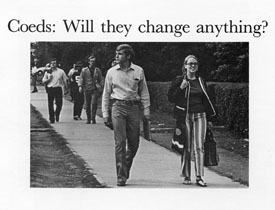First women on campus recall sense of breaking down barriers

'We were breaking down barriers, and I felt good about that.'
– Melanie Willoughby
In its 1972 edition, a few short months before the first women students officially moved onto College Avenue, the Rutgers yearbook Scarlet Letter wondered, “Coeds: Will they change anything?”
A better question might have been: Would anything remain the same?
From adding a gynecologist to the university’s health service to retooling the residence halls, the integration of women into the daily life of New Brunswick’s flagship campus – 40 years ago this September – ushered in adjustments small and large.
“We were fighting a culture that still believed women didn’t belong in college, that they belonged at home with the children,” says Melanie Willoughby, a member of the class who went on to become the first female president of the Rutgers student body and later the first female member of the Rutgers Alumni Association.
“We were breaking down barriers, and I felt good about that.”
Those barriers had begun to fall in September 1970, when the university’s Board of Governors voted to admit women into Rutgers College, an all-male institution since its founding in 1766. But even as far back as 1881, faculty members suggested admitting “young women of proper age and fitness” into the liberal arts curriculum, The New York Times reported.
Women were not a completely alien presence in the years leading up to the transition; many graduate programs were open to female students; and undergraduates at Douglass College (now the Douglass Residential Campus) routinely rode the campus bus across town to take classes that were not available at the all-women’s college, such as journalism.
Livingston College, opened in 1969, had been coeducational since its inception. In 1837, Oberlin became the first coeducational American college; others followed slowly. Down the highway from Rutgers, Princeton opened its doors to women in 1968.
“Clearly, coeducation was a trend that was happening on other campuses around the country,” says Gerald Pomper, at the time a professor of political science at Rutgers and chair of the Livingston Political Science Department, and now Board of Governors professor of political science (emeritus).
Admitting women “was inevitable for Rutgers College to meet the competition,” adds Pomper, who recalls sitting in on many spirited discussions about the change. “This wasn’t a revolutionary thing, as it turns out.”
Unless, of course, you were one of the 450 first-year women who – like Willoughby – moved into dorms equipped with urinals but no shower curtains, who battled lingering resentment from their male counterparts , and who grappled with faculty fears that the coming of women would lower academic standards and provide a distraction for the male student body.
“There might not have been resistance from administration, but there was from some of the upper-classmen,” says Willoughby, now senior vice president of the New Jersey Business and Industry Association, a lobbying group she describes as the largest statewide business association in the country.
“The men would come and knock on my door and say, ‘This could have been my room.’ They resented our being in the classroom.”
Perhaps foreshadowing what she would encounter later in a male-dominated workplace, the history major says she and her female classmates had to lobby for time in the gym, for a part-time gynecologist to join the university’s medical staff, for women’s health necessities to be dispensed.
But Willoughby found a redeeming aspect to the confrontations.
“Even then I knew I wanted to work in politics and government, and that’s definitely a man’s world, so I was very comfortable that I was gaining valuable experience,” she recalls. “I found that being the outsider helped.”
Laura Prado, originally from Cherry Hill, parlayed a psychology major at Rutgers and later a master of social work degree into a job as a social worker/counselor at Columbia High School in Maplewood, where she’s worked for eight years.
Prado recalls an overall heightened awareness on campus, not just over the enrollment of women, but also over issues such as the Vietnam War and racism.
“My general memory is that it was a very exciting time, very challenging. I’m sure being in the first class with women added to sense that this was a special time, a special era. I felt very lucky,” she says. “I loved hearing later that SAT scores were being pushed up because women were applying. I felt great pride that we were strengthening the university.”
In fact, the female first-year students collectively reflected a high level of accomplishment. In a Sept. 10, 1972 story headlined “First Rutgers Coeds Arrive,” The New York Times reported that more than 1,800 women sought one of the coveted slots, the average applicant ranking seventh in a class of 100.
Dr. Arnold B. Grobman, then dean of the college, told the Times that the incoming class, both men and women, comprised one of the most selective classes of any institution of higher education in the country.
Today, the pioneers who turned more than 200 years of Rutgers history on its head have their hands in practically all fields and professions.
According to alumni relations officials, they are physicians and nurses, bankers and business owners, attorneys, educators, journalists and librarians, and government analysts. One is a medical geneticist, another is an editor at The New York Times, another the top administrator of an adult medical day care center, and yet another a federal bankruptcy judge.
Many, like Prado, have gone on to earn advanced degrees, a significant percentage of them at Rutgers. Prado received her MSW from the School of Social Work in 1983.
As the 2012 academic year begins, the gender breakdown for the incoming class at the School of Arts and Sciences, which succeeded Rutgers College as part of a major restructuring in 2006, is 52 percent female and 48 percent male, according to Paul Johnson, vice president of enrollment management.